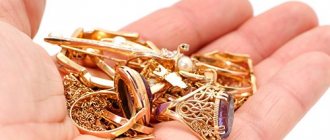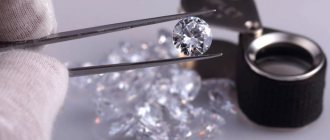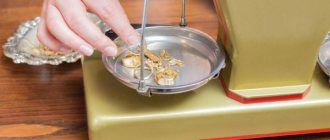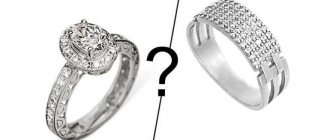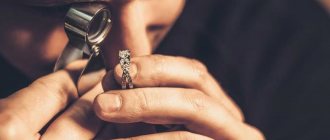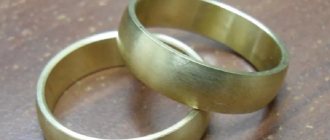Gold jewelry has not ceased to enjoy well-deserved popularity for several centuries, and the demand for it does not fall. This is often used by those who want to make “easy” money by counterfeiting jewelry. The cost of fake jewelry is tens of times lower than that made from real gold.
At the time of purchase, both pieces of jewelry look attractive. And the owner wants to be sure that the product is genuine. Purchasing from a specialized store is less risky, but different situations happen and gold jewelry is purchased in different ways. There are several methods for determining the authenticity of the item you purchased.
This article will discuss how to test gold using iodine.
Pros and cons of the method
Gold is one of the few metals that reacts with halogens. A similar feature is noted in brass, bronze and silver, but it appears much more slowly, and the stain remains less noticeable. Before you decide to test a piece of jewelry for authenticity using iodine, weigh all the advantages and disadvantages of the method.
Pros:
- Iodine is available in every home, and acquiring it is not difficult. The antiseptic is sold without a doctor's prescription.
- No special equipment needed.
- Diagnosis at home is not worth the money that a jeweler will charge if you ask him for an assessment of authenticity.
Minuses:
- It is difficult to clean a gold product from the results of the reaction. It is unlikely that you will be able to handle a chain or bracelet without the help of a jeweler.
- The surface of the product will have to be slightly damaged: scratched or sanded. If this area is not sanded further, dirt will accumulate there during use.
- Caution should be exercised when checking products with stones. If iodine gets on the latter, the reaction may be unpredictable, and the stain will remain forever.
- Some gold items are plated with rhodium, which gives them a special shine. During the procedure, this layer is easily damaged. Even a jeweler cannot help restore it.
other methods
To check, you can use not only iodine, but also other substances, such as lapis pencil, vinegar, magnet. Your own hearing will also help. Many people know these methods. Therefore, if there is no iodine in the house, then it is quite possible to use them as an alternative method.
The lapis pencil contains silver nitrate, which is the active ingredient. The product is used in medicine for the purpose of cauterization. With its help, a test is done, the opposite of iodine. Gold is the only metal that will not react with a pencil. All others will change their color. However, if the product is of low quality, then the result is in question.
All you need to do is leave the decoration in the vinegar for only half a minute, during which you observe the reaction. There will be no reaction to gold. But other metals will begin to oxidize. But, if the sample turns out to be less than 750, then it is also difficult to judge the reliability, as in the previous case.
Attraction with a magnet will reveal the presence of a high iron content in the jewelry. Gold will not react to a magnet. However, at the same time, metals such as aluminum and copper are also not magnetic. Therefore, the experiment will only show the presence or absence of iron.
If a person has a good ear for music, he will be able to distinguish gold, since it is a sonorous metal. To do this, it should be thrown onto a smooth surface. Vibration should be heard, like crystal. Other metals, when hitting the surface, emit a heavy sound that is somewhat harsh on the ear. But, of course, this method cannot be called simple for the average person.
How to test gold with iodine?
Jewelry made of gold will instantly react when iodine gets on the surface. The color of the mark differs depending on the sample:
- 585 produces a noticeable dark brown stain, white gold reacts exactly the same;
- 375 has dark green.
If there is no reaction, it means you have a fake in your hands. The procedure is quite simple. You just need to stock up on some simple equipment:
- pharmaceutical iodine solution;
- latex gloves;
- a cotton swab, which can be replaced with a toothpick, the tip of which is wrapped in cotton wool;
- medical alcohol;
- sandpaper, scalpel or sharp knife;
- magnifying glass;
- soft napkin.
If all this is available, you can begin the procedure following the instructions. Wear gloves before starting work. If iodine gets on the skin of your hands, it will not cause harm. However, it will be quite difficult to wash it. The product that you decide to test must be dry.
- Wipe the gold jewelry thoroughly with cotton wool or a napkin soaked in alcohol. This will be needed to remove dirt from the surface.
- Choose a secluded place where the subsequent stain will not be very noticeable. On a ring this can be the inner surface, on a chain and bracelet - the place near the clasp, on earrings - the area that is inserted into the earlobe. Rub this area with sandpaper or make a scratch with a scalpel or knife.
- Apply iodine to the damaged area. The best way to do this is with a cotton swab. In any case, the smaller the stain, the easier it will be to deal with it in the future. If the product is very small, then add just a little iodine. To see if a speck has formed, use a magnifying glass.
If the metal does not react at all, and the iodine immediately begins to evaporate, it means that your purchase is made of another metal that has nothing to do with gold.
To better understand how the process works, watch the video.
If you are pleased with the result of the test, and the product turns out to be gold, then the question now arises of how to get rid of the stain left by iodine.
Features of testing
Iodine is one of the few elements on the periodic table that can react chemically with an inert metal to form gold iodide. Using this reaction, you can even determine whether the sample that was affixed to the product is too high. When interacting with the surface, a dark spot is formed on it, and each sample has its own characteristic shade.
So, on 750 gold, the stain will acquire a dark green color, 585 – dark brown, and on 385 gold, the dark spot will gradually acquire a greenish tint.
Preparing gold for testing
Gold is not prone to darkening, but an old piece that has not been cleaned for a long time is much duller than a new one. The film of foreign substances that covers it interferes with the chemical reaction. The metal must be cleaned by sanding an inconspicuous area, or polished with GOI paste. A used product that has not lost its shine is sometimes sufficiently wiped with medical alcohol. The preparatory work before the inspection begins will take some time, but without it you cannot vouch for the accuracy of determining the authenticity of the gold.
Test method
The area where iodine will fall should be small, so it’s worth stocking up on tools and materials that will help minimize it:
- pharmaceutical solution of iodine in alcohol;
- medical ethyl alcohol;
- cotton swab;
- a small piece of fine-grained sandpaper;
- dry flannel cloth;
- for small parts - a magnifying glass and tweezers.
Soak a cotton swab in the iodine solution, apply a small amount to the gold item and wait until it dries. This will take a maximum of 5 minutes. After assessing the color of the iodine stain in the treated area, its remnants should be immediately removed with a flannel so that later you do not have to spend a lot of time cleaning the metal. Details of the procedure can be seen in the video.
On a gold product, the iodine will be dark, and the stain will remain for a long time. If this is a fake, the stain will quickly lighten and the iodine will begin to evaporate.
The rate of the chemical reaction does not depend on the size of the treated area and occurs at room temperature under normal conditions. It is better to apply iodine from the wrong side or inside of the product. To clearly see a small speck, you can use a magnifying glass.
Disadvantages of the method
The main disadvantage is that only the outer surface of the product will be tested with iodine. If there is a layer of gold on it, the reaction will occur exactly the same as on gold. Trying to sand the surface, you can easily damage the gilding and the jewelry will be damaged. Difficulties will also arise when checking products coated with rhodium, which is more expensive than gold. The platinum group metal does not react with iodine, and peeling off the protective layer is highly not recommended.
Professional products
In a jewelry store you can find products designed to care for items made of precious metals. They are available in the form of wipes or liquid. When purchasing, pay attention to the information on the label, as some of them allow you to clean jewelry with stones, and some warn you not to do this.
The most popular: “Aladdin”, CONNOISSEURS, Antiquax Gold Dip.
Try to purchase jewelry only from trusted sellers. If you still had to buy the product secondhand, then try checking its authenticity using iodine.
Instructions
Probably everyone has such a drug as iodine at home. If not, then it can easily be purchased at a pharmacy, since it does not require a doctor's prescription and is cheap. In medicine, iodine is considered an antiseptic. However, it is also used for other purposes. For example, a widely known method for testing gold is iodine, where it is used as an indicator to determine the authenticity of the metal. However, the drug will only help in recognizing gold. For other metal products it will not show the true result. So, having decided to try this method, you need to do the following.
- They take gold jewelry. Usually, doubts arise in samples 583 and 585, since their tint may be slightly reddish, which can raise doubts. But it may also be associated with the presence of an alloy in the metal composition.
- Then the product is lightly sanded on the inside. This is necessary for the reaction with iodine to occur. Most often, sandpaper is used for this, although you can use another abrasive.
- After soaking a cotton swab in iodine, apply it to the gold item in the place of wear. It doesn’t matter whether a small or large amount of iodine will participate in the reaction. Therefore, you need to try to apply only a small, unnoticeable spot. The reaction will not increase depending on the size of the abrasion area, but then you will have to spend more effort to wash it, and a trace of abrasion may remain.
- It remains to monitor the reaction. If a dark color stain appears, then the jewelry is genuine. It is precisely made of precious metal. But if the color remains the same, then the product is not gold, but bronze, copper or brass. The chemical reaction occurs because gold is able to react with halogens. And iodine is exactly that.
How to find out the hallmark of a gold product at home: Archimedes' method
To carry out the test, we will need electronic scales, a calculator, and water. The method is based on Archimedes' law, according to which we determine the density of the product and compare it with the standard. To calculate, we need to know the weight of the product and the weight of the displaced liquid. Then perform a mathematical operation and compare it with the table of metal densities. More similar, it is described in the video - how to determine real gold and its purity by water:
Precious metal density table:
| metal | Silver | Gold 375, 500 | Gold 583, 585 | Gold 750 | Gold 999 |
| density | 9 — 10 | 11 — 12 | 12 — 14 | 14 — 17 | 19,3 |
How to determine a sample
You can determine the sample at home. To do this, you need to prepare gold chloride, alcohol, and a pipette. The product is thoroughly cleaned of dirt, grease, and fingerprints. To do this, wipe thoroughly with a cloth moistened with alcohol. After the procedure, the alcohol should completely evaporate. Using a pipette, drop a small amount of gold chloride and apply it to the object being examined. Leave for five minutes.
For an alloy with a purity lower than 585, the stain from the solution will turn brown. Brass and an alloy of silver and copper will turn black in a couple of seconds. Gold 585 and higher will remain unchanged. If you need exact numbers and you won’t be able to find them out at home, you should contact a laboratory.
We recommend: 10 tips that will help you get everything done before the New Year
Jeweler services as a reliable and safe way to verify the authenticity of metal
Traditional methods of metal testing are good as an express method. For reliability and confidence in the results, you should contact a professional jeweler. In his arsenal there will be all the necessary means of determining the authenticity of a gold product.
The jeweler always has the necessary tools at hand to test precious metals.



